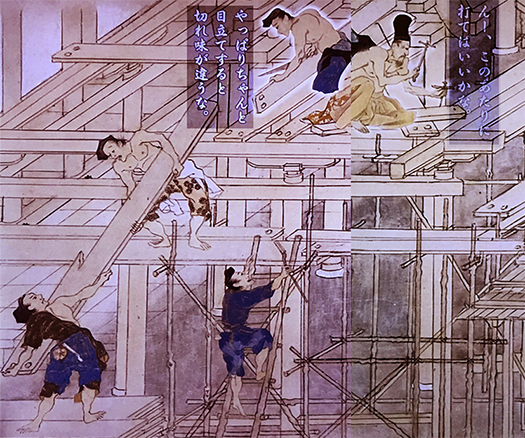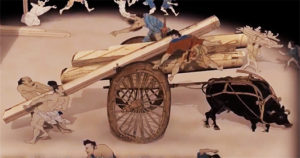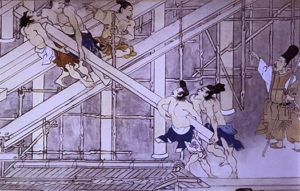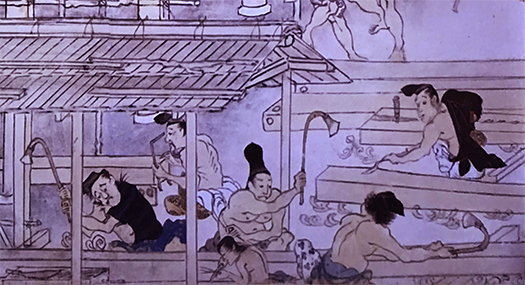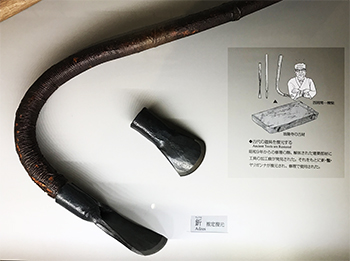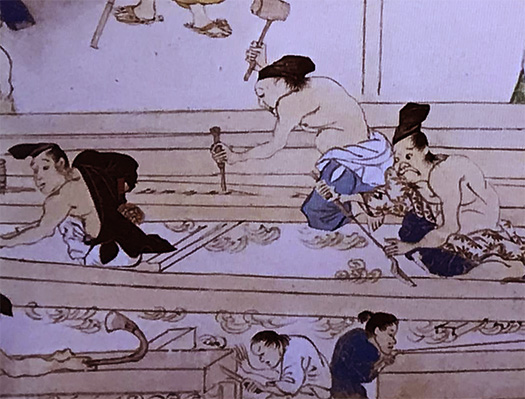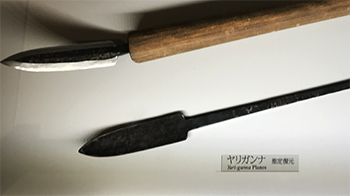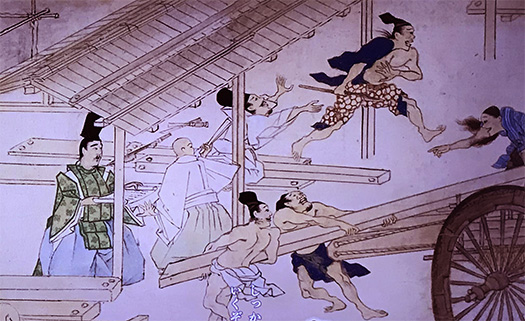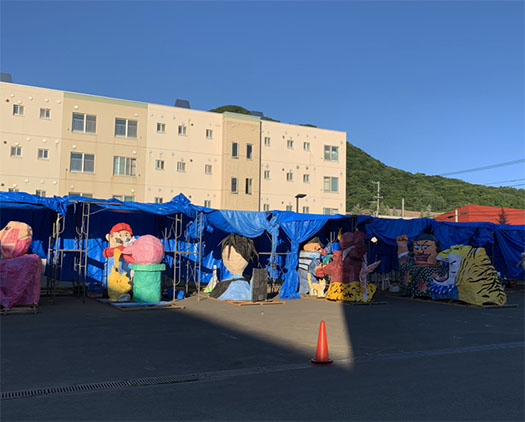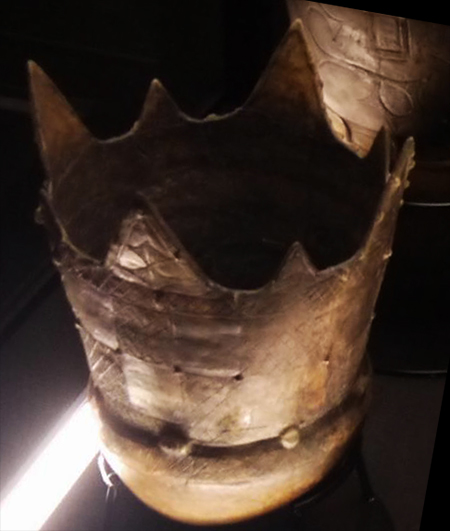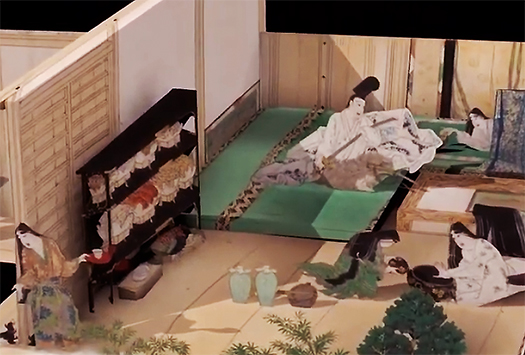
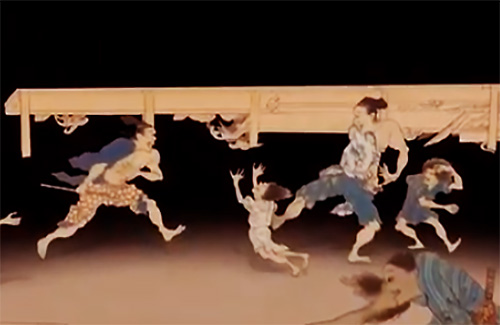
さて木造建築の工程が視覚化されている松崎天神縁起絵巻をみてきましたが、
この絵巻では当時の社会の様子がうかがえるような描写もある。
上の絵巻絵は菅原道真が多くの人に加護を与えた奇譚が描写されている。
〜巻5 【天神様のご利益】
天神さまはあらゆる願いを叶えて下さる神となりました。
ある時は濡れ衣を晴らし、ある時は極楽往生を助け、ある時は良縁を授け、
またある時は病を払って下さいます。巻4の後半と巻5では、
天神様が叶えた数々の不思議とご利益が綴られます。〜
・・・ということでこの絵では継子いじめにあっていた姉妹が
道真の加護を受けて玉の輿に乗るお話しを描いているとされる。
3場面もの長さで語られていて、当時の社会の「憧れ」の事件だったことがわかる。
平安中期を生きた人びとにとって、菅原道真という存在は
ある種の結界装置のように受け止めていた可能性がある。
宮廷社会は一般庶民のくらしの遙か上層で「上級国民」が繰り広げる世界。
その影響はさまざまに民の暮らしにも出ていただろうけれど、
その世界とのバイパス的な機縁を菅原道真にみていたのではないだろうか。
後の世での義経にも似た民衆の仮託対象であったように感じる。
絵巻を編纂するにあたって、この社をひとに紹介するのに、
「あのお話」というキーワード的な事件性がこの絵には込められたのではないか。
日本社会は比較的に身分階層の対流性のいい社会だと思うけれど、
学問というのは、そういう対流性がもっとも大きかったものであり、
その天才としての菅原道真であれば超越的に対流を起こせると夢見させたのか。
奇跡のような身分上昇を現出させた事実があったに違いない。
やがて時代は武士階層の勃興によって、宮廷政治は力を失っていくけれど、
人々はこういう上級国民層に退廃を強く感じ続けていたように思える。
下の絵は工事現場絵巻の一部分にみえたワンシーン。
工事現場で作業していた職人さんがわが子が大人に足蹴にされているのを見て
いまにもつかみかからんばかりの勢いで向かっていっている。
「うっせーな、このガキ、すっこんでやがれ!」
(足蹴)
「おい、このヤロー、ウチの坊主に何しやがんでぇ」
っていうようなケンカ沙汰が1100年の時代を超えてコダマしてくる(笑)。
足蹴にしているオトナの手にはなにかが抱えられているので、
あるいは子どもからなにか大事なモノを奪い取ったのかもしれない。
木工職人としての父親が近くにいたということは、
どういうことか? ひとつの推定として職人は地元で工事に採用された人間で
家の近所が工事現場という環境で子どもたちは父親の仕事ぶりを見学して
一子相伝の技術伝授を行っていた最中であったかも知れない。
そういうマジメな研修の合間に悪ガキ仲間でつるんで悪さをしたのかも。
もしそうであると、犯罪者は逆であるかも知れない。
時空間を越えた第3者としてはうかつには正邪の判定は付きにくい。
しかし「足蹴」の時点でオトナには非があることは疑いない。
こういう社会のリアルな姿の一端が、
絵巻物に表現されているというのは現代人にも親近感が湧く。
English version⬇
[Society 1100 years ago in the lucky picture scroll / Special edition of a good house in Japan ㊲-6]
Now, I have seen the Matsuzaki Tenjin Engi Emaki, which visualizes the process of wooden construction.
In this picture scroll, there is also a depiction that shows the state of society at that time.
The picture scroll above depicts the miracle that Sugawara no Michizane gave blessings to many people.
~ Volume 5 [Benefits of Tenjin]
Tenjin has become a god who grants all wishes.
Sometimes I get rid of my wet clothes, sometimes I help paradise, and sometimes I give a good match,
At other times, please pay for the illness. In the second half of Volume 4 and Volume 5,
Many wonders and benefits that Tenjin has fulfilled are spelled out. ~
So, in this picture, the sisters who were being bullied by stepchildren
It is said that he is drawing a story about riding a ball with Michizane’s blessing.
It is told in three scenes in length, and it can be seen that it was a “longing” case of society at that time.
For those who lived in the middle of the Heian period, the existence of Sugawara no Michizane
He may have taken it like a barrier device of some sort.
The court society is a world where “senior citizens” unfold, far above the lives of ordinary people.
The influence would have been in the lives of the people in various ways,
Perhaps Sugawara no Michizane was looking at a bypass-like relationship with that world.
I feel that it was a temporary subject of the people, similar to Yoshitsune in the later world.
To introduce this company to people when compiling picture scrolls
I think this picture has the keyword “that story”.
I think Japanese society is a society with relatively good convection in the social class,
Academics are probably the ones that had the greatest convection.
Did you dream that Sugawara no Michizane as a genius would be able to transcend convection?
There must have been a fact that a miraculous rise in status was revealed.
Eventually, due to the rise of the samurai class, court politics lost its power,
It seems that people continued to strongly feel the decadence of these senior citizens.
The picture below is a scene that looks like a part of a construction site picture scroll.
A craftsman working at a construction site sees his child being kicked by an adult
He is heading with a momentum that he can’t grasp at any moment.
“Usseewa, this kid, go ahead!”
(kick)
“Hey, this yarrow, what’s wrong with my shaven?”
That kind of quarrel has gone beyond the 1100 era (laughs).
Something is held in the hand of the adult who is kicking, so
Or it may have stolen something important from the children.
The fact that his father as a woodworker was nearby
What do you mean? One estimate is that the craftsman is a locally hired person for construction.
In an environment where the neighborhood of the house is a construction site, children observe the work of their father
It may have been in the middle of teaching the technique of Ichiko Soden.
Perhaps he did something wrong by hanging out with his bad boys during such serious training.
If so, the criminal may be the other way around.
As a third party who transcends time and space, it is difficult to judge whether it is right or wrong.
However, there is no doubt that there is something wrong with adults at the time of “foot kick”.
A part of the real appearance of this kind of society
It is very interesting that it is expressed in a picture scroll.
Posted on 7月 29th, 2021 by 三木 奎吾
Filed under: 住宅マーケティング, 日本社会・文化研究 | No Comments »



